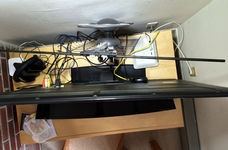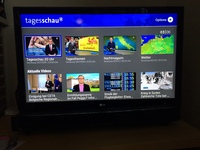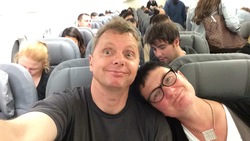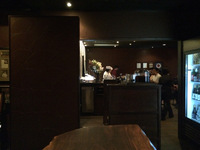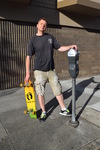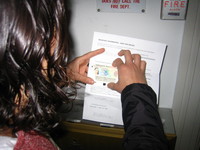 |
| Angelika/Mike Schilli |
|
Michael The Bay Area cable TV de facto monopolist Comcast, known for continuously hiking their montly fees, has lately drawn some consumer criticism. They're offering Internet and cable TV service as low as $50 for new customers, only to increase the price to $150 six months later. You've got that right, Americans are paying $150 per month for Internet and cable access, while it's often less than $50 in Europe. It's the result decades of failed politics, granting a price gouging monopolistic company free reign, as we've outlined in a previous issue (Rundbrief 12/2010).
But there's a growing number of Americans who are fed up with overpaying for cable, who've set out to cut ties with their providers, under the banner "Cut the Cord". That's not hard to do, as aside from cable, Internet can be had through the telephone as DSL, or via a separate fiber line, and even for cable TV there are a few perfectly legal options without going through monopolistic providers like Comcast.
There's a steady inflow on Amazon of books dealing with guides to "Cut the Cord", and even my hygienist recently quizzed me about the possibilities while polishing my choppers. As many of our readers know, I'm usually ahead of the technical curve, compared to the rest of mankind by two, three years, and have indeed discontinued cable service three years ago. Ever since then, whenever I drive by our Comcast store, I give them a nice wave and burst out laughing.
But luckily, we're located here directly in the eye of a technology hurricane, with plenty of hungry whippersnappers constantly inventing new gadgets, trying to blow dinosaurs like Comcast out of the water. It is indeed quite simple to legally receive free TV programs in the Bay Area. Today, I'm going to open the curtain to show how this is working for us. First off, there's local TV stations, broadcasting evening news and maybe a baseball game, or political content on stations like KQED who make TV programs with balanced reports and interviews for the few people around here who haven't completely lost their minds yet.
Apparently because receiving TV programs is some form of basic human right, select broadcasting stations offer their programs as digital TV through the airwaves, sent to the users' home antennas (OTA=Over the Air). Just like in Germany with DVB-T this isn't your grampa's snowy TV reception, with scrolling pictures, requiring the occasional signature whack onto the top TV with the flat hand to stop. OTA is digital, so it either works perfectly or not at all. As you might know, our location in San Francisco is very close a widely visible broadcasting antenna called "Sutro Tower", at the top of the "Twin Peaks" hill close to the geographic center of the city. After rummaging through Amazon's antenna section and reading the reviews, I finally settled for one that cost $80, and placed it behind our TV (Abbildung 1. The reception is quite good, not only from stations broadcasted from Sutro Tower, but also those coming in from San Bruno, which is 20 miles further south.
Now, as a self-respecting person with a job, without lots of idle time to lounge on the couch all day long, you might find watching TV in the U.S. very annoying and a waste of your personal time, since the stations keep interrupting their programs every few minutes to broadcast commercials. For this reason, if you decide to cut the cord, the first thing you need is a digital video recorder to tape programs and skip over commercials at the push of a button. I've been using a so-called TiVo since it came out about 16 years ago, and have been a loyal customer until today, even upgrading to a newer "TiVo Roamio" a few years ago, an astounding machine with six separate TV tuners all able to record programs on different channels at the same time (Figure 3).
You tell the TiVo which programs to record, without having to deal with start times or channels, just by entering the name of the show. It then finds out when those TV series or news shows are being broadcasted and where, and simply records them all. With this setup in place, you'll never watch live TV anymore, instead, there's twenty shows to choose from when you come home, dutyfully selected during the day and recorded by your TiVo, ready for your consumption, even when the recording is still in progress, with a quick way to skip any commercials on the way.
We're trying to stay informed on world politics and in particular keep up to date with what's going on in Germany, which is why we watch the German 8pm news show "Tagesschau" almost every single day. For this, we're using a streaming device called "Roku", which is similar to an Apple TV or an Amazon Fire, both of which we happen to have connected as well. It takes the Roku about ten seconds to start the video stream and the quality is similar to what you'd expect in Germany with your cable provider (Figure 6).
With so many electronic gadgets connected to the TV, it just happens that every once in a while, one of them stops working and needs to be rebooted, and because the cabling in the TV cabinet is somewhat confusing, I've added a switchboard with ten labeled buttons providing power to the different devices. In case a reboot of a particular device is required, Angelika can find the laser printer labeled switch on the array that looks like it came from professional audio studio, and toggle it to switch power of a specific device off and on again, in order to restart it and jerk it back to life. Sometimes she will complain nevertheless about our entertainment system being in a constant state of disarray, because it just happens that every so often, I replace a perfectly working gadget with a brand new unreliable one, which is when I tell her: "The only constant is change!".
Greetings from the country that creates new things non-stop:
Angelika und Michael
